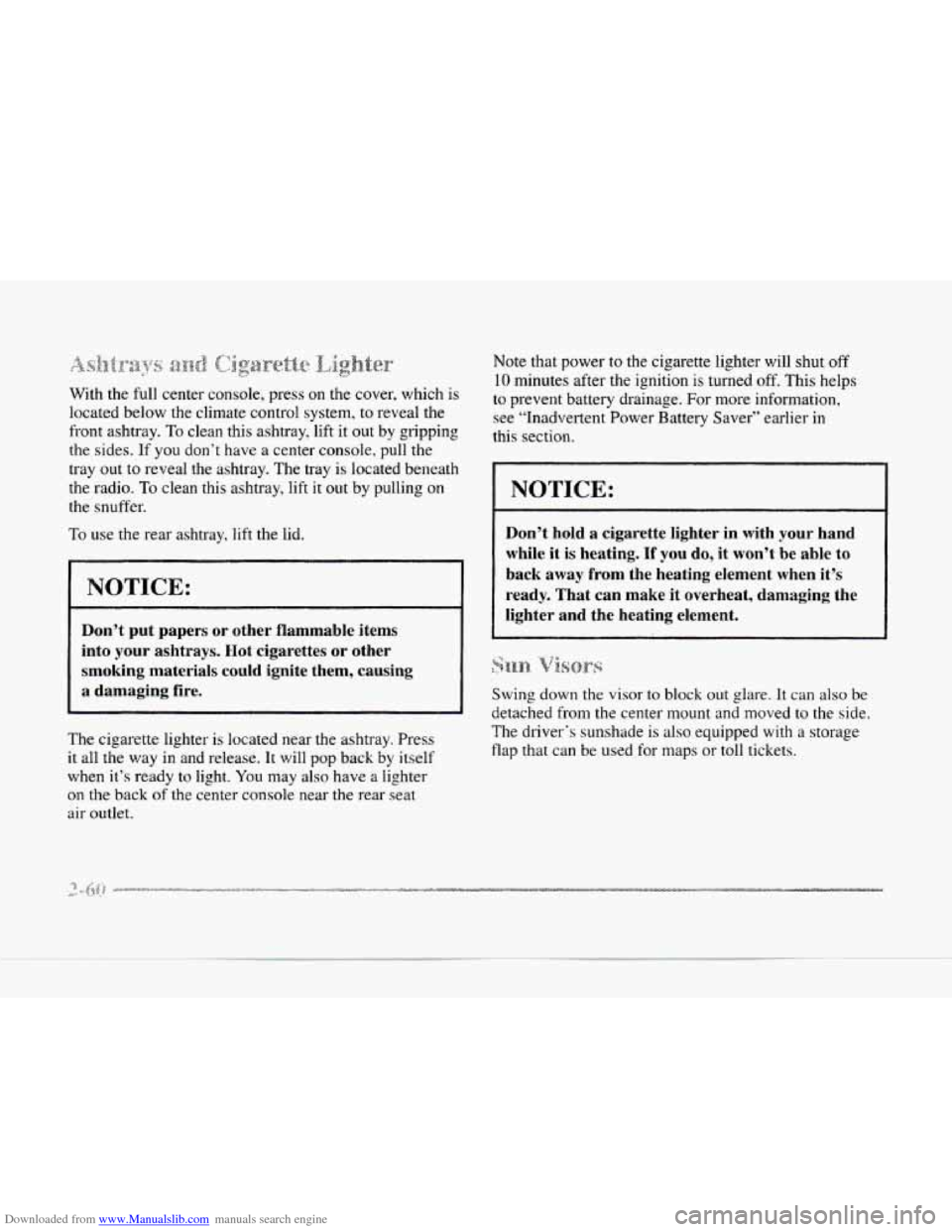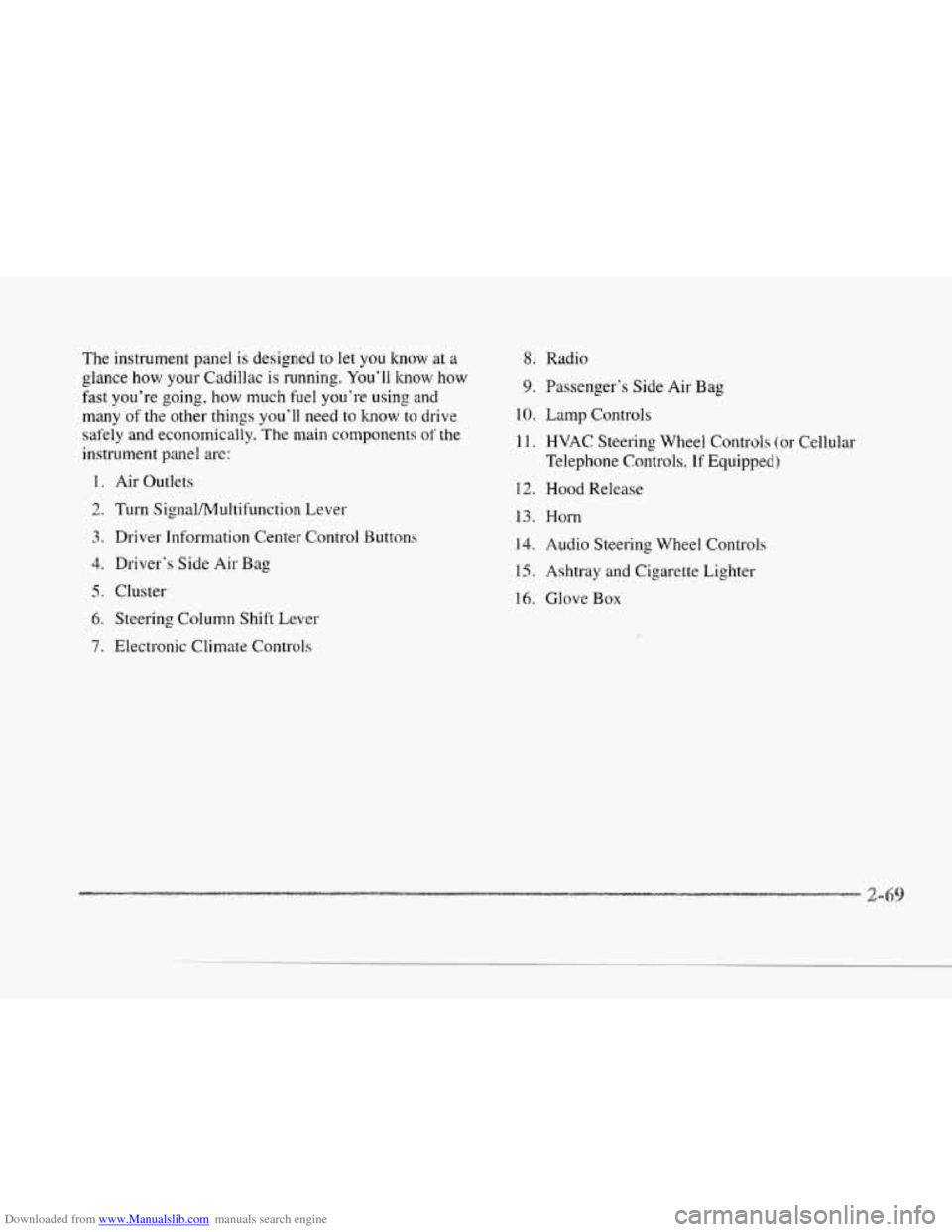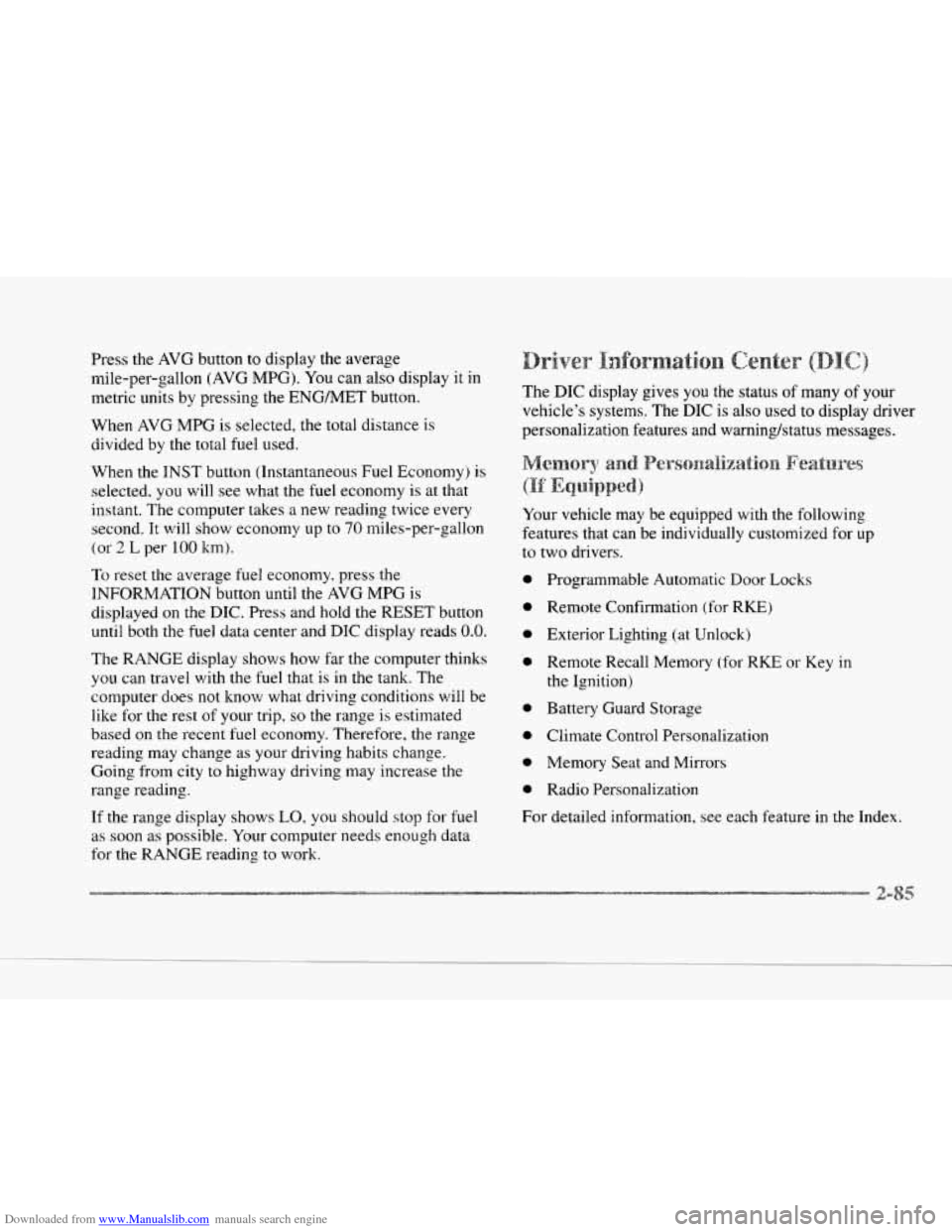1997 CADILLAC SEVILLE climate control
[x] Cancel search: climate controlPage 10 of 370

Downloaded from www.Manualslib.com manuals search engine c
c
c
advances such as air suspension, memory seat,
automatic electric door locks. transistor radio,
a brushecl
stainless
steel roof and low profile tires.
For the 1948 model, Cadillac introduced the legendary
tail fin which once more set the trend in automotive
styling for nearly two decades. This
was closely
followed with the two door hardtop Coupe DeVille and
the industry's first modern overhead valve, high
compression
V8 engine on the 1949 model.
Engineering innovations, conveniences
and styling
dominated the
'50s and '60s. Cruise control, automatic
climate control, tilt
and telescoping steering wheels,
twilight sentinel and
four door hard tops all debuted in
these years.
Ir, 1557 the Eldorado Brougham featured
1957 Eldorado Brougham
:.x
The Eldorado, introduced in 1953, was redesigned for
1967
as the first front wheel drive personal luxury car.
The
472 cu. in. V8 engine used in all Cadillacs in I568
and 1965 was enlarged to SO0 cu. in. for all 1970
through 1976 Eldorados. The Track Master
conlputerized skid control braking system option
debuted
on 1970 Eldorados.
A driver and passenger Air Cushion Restraint
system (air bag) was available on
all 1974. I975 and
1976 Cadillacs.
Analog Electronic
Fuel Injection was available, on
1975 Cadillacs and standard 011 the new international
size
1976 Seville. In 1978, the Trip Computer option
incorporated the first on-board microprocessor.
ix
Page 95 of 370

Downloaded from www.Manualslib.com manuals search engine It’s better not to park with the engine running. But if you
ever have to, here are some things to know.
A CAUTION:
Idling the engine with the climate control system
off could allow dangerous exhaust into your
vehicle (see the earlier Caution under
“Engine Exhaust”).
Also, idling in a closed-in place can let deadly
carbon monoxide
(CO) into your vehicle even
if the fan switch is at the highest setting. One
place this can happen is
a garage. Exhaust -- with
CO -- can come in easily. NEVER park in a
garage with the engine running.
Another closed-in place can be
a blizzard. (See
“Blizzard” in the Index.)
A CAUTION:
It can be darlgerous to get out of your vehicle if
the shift lever
is not fully in PARK (P) with the
parking brake firmly set. Your vehicle
can roll.
Don’t leave your vehicle when the engine is
running unless you have to.
If you’ve left the
engine running, the vehicle can move suddenly.
You or others could be injured.
To be sure your
vehicle won’t move, even when you’re on fairly
level ground, always set your parking brake after
you move the shift lever to
PARK (P).
Follow the proper steps to be sure your vehicle won‘t
move. See ”Shifting Into
PARK (P)“ in the Index.
If you are parking on a hill and if you’re pulling a
trailer> also see “Towing a Trailer” in the Index.
Page 121 of 370

Downloaded from www.Manualslib.com manuals search engine *;!&fgyg.yS 8 ignd ~~~~~~~~~ .%
With the full center console, press on the cover, which is
located below the climate control system, to reveal the
front ashtray.
To clean this ashtray, lift it out by gripping
the sides. If you don’t have a center console, pull the
tray
out to reveal the ashtray. The tray is located beneath
the radio.
To clean this ashtray, lift it out by pulling on
the snuffer.
To use the rear ashtray, lift the lid.
NOTICE:
Don’t put papers or other flammable items
into your ashtrays. Hot cigarettes or other
smoking materials could ignite them, causing
a damaging fire.
The cigarette lighter is located near the ashtray. Press
it all the way in and release. It will pop back by itself
when it’s ready to light.
You may also have a lighter
on the back of the center console near the rear seat
air
outlet.
Note that power to the cigarette lighter will shut off
10 minutes after the ignition is turned off. This helps
to prevent battery drainage. For more information,
see “Inadvertent Power Battery Saver” earlier in
this section.
NOTICE:
Don’t hold a cigarette lighter in with your hand
while it
is heating. If you do, it won’t be able to
back away
from the heating element when it’s
ready. That can make it overheat, damaging the
lighter and the heating element.
Swing down the visor to block out glare. It can also be
detached from
the center mount and moved to the side.
The driver‘s sunshade is also equipped with a storage
flap that can be used for maps or toll tickets.
Page 130 of 370

Downloaded from www.Manualslib.com manuals search engine P
c
The instrument panel is designed to let you know at a
glance how your Cadillac is running. You’ll know how
fast you’re going, how much fuel you’re using and
many of‘the other things you’ll need to know to drive
safely and economically.
The main components of the
instrument panel are:
1. Air Outlets
2. Turn Signal,/Multifi~nctioln Lever
3. Driver Information Center Control Buttons
4. Driver’s Side Ais Bag
5. Cluster
6. Steering Column Shift Lever
7. Electronic Climate Controls
8. Radio
9. Passenger’s Side Air Bag
10. Lamp Controls
1 I. HVAC Steering Wheel Controls (.or Cellular
Telephone Controls.,
If Equipped)
12. Hood Release
13. Horn
14. Audio Steering Wheel Controls
15. Ashtray and Cigarette Lighter
16. Glove Box
Page 146 of 370

Downloaded from www.Manualslib.com manuals search engine IC-
Press the AVG button to display the average
mile-per-gallon (AVG MPG). You can also display it in
metric units by pressing the
ENGMET button.
When AVG MPG
is selected, the total distance is
divided by the total fuel used.
When the INST button (Instantaneous Fuel Economy) is
selected. you will see what the fuel economy is at that
instant. The computer takes
a new reading twice every
second.
It will show economy up to 70 miles-per-gallon
(or 2 L per- 100 ltm).
To reset the average fuel economy, press the
INFORMATION button until the AVG MPG is
displayed on the DIC. Press and hold the
RESET button
until both the fuel data center and DIC display reads
0.0.
The RANGE display shows how far the computer thinks
you can travel with the fuel that is in the tank. The
computer does
not know what driving conditions will be
like for the rest of your trip,
so the range is estimated
based on
the recent fuel economy. Therefore, the range
reading may change
as your driving habits change.
Going from city
to highway driving may increase the
range reading.
If the range display shows
LO, you should stop for fuel
as soon
as possible. Your computer needs enough data
for the RANGE reading to work. The
DIC display gives you the
status of many of your
vehicle’s systems. The DIC is also used to display driver
personalization features and warninghtatus messages.
Your vehicle may be equipped with the following
features that can be individually customized for up
to two drivers.
0
0
0
0
0
0
0
0
Programmable Automatic Door Locks
Remote Confirmation (for
RKE)
Exterior Lighting (at Unlock)
Remote Recall Memory (for RKE or Key
in
the Ignition)
Battery Guard Storage
Climate Control Personalization
Memory Seat and Mirrors
Radio Personalization
For detailed information, see each feature in the Index.
Page 147 of 370

Downloaded from www.Manualslib.com manuals search engine DISPLAY ON/OFF: Pressing this button will turn off
the DIC, Electronic Climate Control (ECC). fuel data
center, the fuel gage. trip odometer- and odometer.
While
the displays are off, pressing the INFORMATION
button will only turn on the DIC. If the TRIP SET
button is pressed or the fuel level falls below fout-
e aallons (15.2 L), all of the displays will come back on.
ENG/MER You can change the display from English
(miles) to metric (kilometers) by pressing
this button.
The same button
also changes other readings (like
temperature, fuel and odometer).
TRIP SET By using this button. you can tcll how Far
you've gone since you last sct t11c TRIP SET back to
zero. To reset, press and hold thc button until XI-OS
appear. If your vehicle is domestic. the trip odonwrcr
will return to zero after 999.9 mi Ics ( I 009 km). I I' !XNII-
vehicle is Canadian, the trip odcmctcr will return lo zero
after 1 999.9 km (1,242 miles ).
INFORMATION: Pressing this button repcatccll), ivill
display the MPG AVG, MPG INST. GAL FUEL LJSED,
AVG MPH, ENGINE RPM. BATTERY VOLTS.
COOLANT TEMP and OIL LIFE LEFT.
TIMER: This feature is like a stopwatch, in that you
can clock the time it takes to get from one point to
another.
To operate, press the TIMER button
until TIMER OFF
0O:OO:OO is displayed on the DIC. Each of the fields for
the hours, minutes and seconds are two numeric digits.
Page 150 of 370

Downloaded from www.Manualslib.com manuals search engine LI
e
OIL LIFE LEFT (Reset): Press the INFO button to
display the OIL LIFE LEFT, then press and hold the
INFO RESET button until
100% OIL LIFE LEFT is
displayed. (This only needs to be reset after you have
had the oil changed.)
ENGLISHMETRIC (Reset): Press the INFO button
to display ENGLISHMETRIC
RESET, then press the
INFO RESET button to select. The display will change
from English (miles)
to metric (kilometers).
INFO: Pressing this button repeatedly will display the
RANGE, MPG AVG, MPG INST, GAL FUEL USED,
MPH, AVG MPH, TIMER. BATTERY VOLTS.
COOLANT TEMP, OIL LIFE LEFT and
ENGLISHMETRIC RESET.
FUEL DOOR: Press this button to open the fuel
door. (This feature will work only when the shift lever
is in PARK (Pj regardless of whether or not the vehicle
is running.)
TRUNK: Press this button to open the trunk. (This
feature will work only when the shift lever
is in
PARK
(P) regardless of whether or not the vehicle
is running.) These
messages will appear if there is
a probien.; sensd
in one of your vehicle's systems. V'hicles that are first
sold in Canada will have a number after each message.
This number helps to identify the message which
is only
displayed in English.
A/C OFF FOR ENGINE PROTECTION - 16: This
message displays when the engine coolant becomes
hotter than the normal operating temperature. To avoid
added strain on a hot engine, the air conditioning
compressor
is automatically turned off so that air
conditioned air
is not deljvered. If the coolant
temperature returns to normal,
you must select AC to
return to a normal A/C compressor operation. If this
message continues to appear, have
the system repaired
as soon as possible to avoid compressor damage.
APPLY BRAKE TO SHIFT - 46: This message will
appear if your vehicle is in PARK (P) for about
15
seconds and the brake is not pressed in. To remove this
message from the
DIC display, hold the OFF and the
blue (cooler) buttons on the digital cluster climate
control panel for about five seconds. On the analog
cluster climate control panel, press the OFF button
(next to the MODE button) and the down arrow on the
PASS
TEMP button for about five seconds. Hold the
same two buttons to display the message again.
Page 151 of 370

Downloaded from www.Manualslib.com manuals search engine BATTERY NO CHARGE - 07: This message will
appear if the battery is not being charged. Have the
electrical system checked by your Cadillac dealership
at
your earliest convenience.
BATTERY VOLTS HIGH - 08: This message shov:~
that the electrical charging system is overcharsing :'more
than 16 volts). To avoid being stranded, have the
electrical system checked by your Cadillac dealership.
YOU can reduce the charging overload by
using the
accessories.
TU^ on the lamps and radio. set the climate
control on AUTO and the fan speed
011 HI. and turn the
rear window defogger
on. You can monitor battery
voltage on the
DIC by pressing the INFORMATION
(INFO) button. The normal range
is 11.5 to 15.5 volts
when the engine
is running.
BATTERY VOLTS LOW - 06: This message will
appear when the electrical system
is charging less than
10 volts or if the battery has been drained. If this
message appears immediately after starting, it
is possible
that the generator can still recharge the battery. The
battery should recharge after driving a few miles and
the
message should go out. If this message appears while
driving or after starting your vehicle and stays
on, have
it checked immediately
to determine the cause of this
problem.
To help the generator recharge the battery
quickly, you can reduce the load
on the electrical system
b>. turning off the accessories. You can monitor battery
voltage on the
DIC by pressing the INFORMATION
(INFO) button. The normal range is 11.5
to 15.5 volts.
BRAKE VACUUM PROBLEM -108: The circuit in
the brake booster vacuum has shorted or
is loose when
this message appears. Your vehicle may lose power
brakes but you will
still have the use of manual brakes.
The power brakes will not be affected if the problem is
caused by
a failed sensor. Have your vehicle serviced
immediately at your Cadillac dealership.
CHANGE ENGINE OIL - 82: This means that the life
of the engine oil has expired and it should be changed
within
200 miles. See "Engine Oil" and "Filter
Recommendations" in the Maintenance Schedule booklet.
After an
oil change. the'Oi1 Life Indicator must be reset.
See *'Oil Life Indicator''
in the Index on how to reset it.
CHANGE TRANS FLUID - 47: This message will
appear when it is time
to replace the transaxle fluid. See
the Maintenance Schedule booklet for the proper fluid
and change intervals.
CHECK BRAKE FLUID LEVEL - 37: This message
will display if the ignition
is in the RUN position to
inform the driver that the brake fluid level is low. Check
the brake reservoir level and add fluid as needed. Have
the brake system serviced by a Cadillac technician as